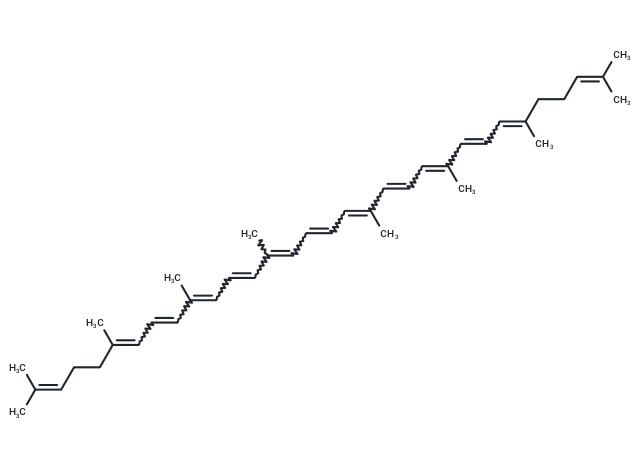- Remove All
 Your shopping cart is currently empty
Your shopping cart is currently empty
Shopping Cart
Lycopene
Catalog No. T2864Cas No. 502-65-8
Alias ψ,ψ-Carotene
Lycopene (ψ,ψ-Carotene) is a linear, unsaturated hydrocarbon carotenoid, the major red pigment in fruits such as tomatoes, pink grapefruit, apricots, red oranges, watermelon, rosehips, and guava. As a class, carotenoids are pigment compounds found in photosynthetic organisms (plants, algae, and some types of fungus), and are chemically characterized by a large polyene chain containing 35-40 carbon atoms; some carotenoid polyene chains are terminated by two 6-carbon rings. In animals, carotenoids such as lycopene may possess antioxidant properties which may retard aging and many degenerative diseases. As an essential nutrient, lycopene is required in the animal diet.

Lycopene
Catalog No. T2864Alias ψ,ψ-CaroteneCas No. 502-65-8
Lycopene (ψ,ψ-Carotene) is a linear, unsaturated hydrocarbon carotenoid, the major red pigment in fruits such as tomatoes, pink grapefruit, apricots, red oranges, watermelon, rosehips, and guava. As a class, carotenoids are pigment compounds found in photosynthetic organisms (plants, algae, and some types of fungus), and are chemically characterized by a large polyene chain containing 35-40 carbon atoms; some carotenoid polyene chains are terminated by two 6-carbon rings. In animals, carotenoids such as lycopene may possess antioxidant properties which may retard aging and many degenerative diseases. As an essential nutrient, lycopene is required in the animal diet.
| Pack Size | Price | Availability | Quantity |
|---|---|---|---|
| 20 mg | $50 | In Stock |
Bulk & Custom
Add to Cart
Questions
View MoreSelect Batch
Purity:98.47%
Contact us for more batch information
All TargetMol products are for research purposes only and cannot be used for human consumption. We do not provide products or services to individuals. Please comply with the intended use and do not use TargetMol products for any other purpose.Product Introduction
Bioactivity
Chemical Properties
| Description | Lycopene (ψ,ψ-Carotene) is a linear, unsaturated hydrocarbon carotenoid, the major red pigment in fruits such as tomatoes, pink grapefruit, apricots, red oranges, watermelon, rosehips, and guava. As a class, carotenoids are pigment compounds found in photosynthetic organisms (plants, algae, and some types of fungus), and are chemically characterized by a large polyene chain containing 35-40 carbon atoms; some carotenoid polyene chains are terminated by two 6-carbon rings. In animals, carotenoids such as lycopene may possess antioxidant properties which may retard aging and many degenerative diseases. As an essential nutrient, lycopene is required in the animal diet. |
| Alias | ψ,ψ-Carotene |
| Molecular Weight | 536.87 |
| Formula | C40H56 |
| Cas No. | 502-65-8 |
| Smiles | CC(C)=CCCC(C)=CC=CC(C)=CC=CC(C)=CC=CC=C(C)C=CC=C(C)C=CC=C(C)CCC=C(C)C |
| Relative Density. | 0.888 g/cm3 |
Storage & Solubility Information
| Storage | keep away from direct sunlight,store at low temperature | Powder: -20°C for 3 years | In solvent: -80°C for 1 year | Shipping with blue ice. | ||||||||||||||||||||
| Solubility Information | DMSO: 5.37 mg/mL (10 mM), Sonication is recommended. | ||||||||||||||||||||
Solution Preparation Table | |||||||||||||||||||||
DMSO
| |||||||||||||||||||||
Calculator
In Vivo Formulation Calculator (Clear solution)
Please enter your animal experiment information in the following box and click Calculate to obtain the mother liquor preparation method and in vivo formula preparation method:
Mother liquor preparation method: 2 mg of drug dissolved in 50 μL DMSO (mother liquor concentration of 40 mg/mL), if you need to configure a concentration that exceeds the solubility of the product, please contact us first.
(mother liquor concentration of 40 mg/mL), if you need to configure a concentration that exceeds the solubility of the product, please contact us first.
Preparation method for in vivo formula: Take 50 μL DMSO main solution, add 300 μLPEG300
main solution, add 300 μLPEG300 mix well and clarify, then add 50 more μL Tween 80, mix well and clarify, then add 600 more μLddH2O
mix well and clarify, then add 50 more μL Tween 80, mix well and clarify, then add 600 more μLddH2O mix well and clarify
mix well and clarify
For Reference Only. Please develop an appropriate dissolution method based on your laboratory animals and route of administration.
Dose Conversion
You can also refer to dose conversion for different animals. More Dose Conversion
Tech Support
Please see Inhibitor Handling Instructions for more frequently ask questions. Topics include: how to prepare stock solutions, how to store products, and cautions on cell-based assays & animal experiments, etc
Keywords
Related Tags: buy Lycopene | purchase Lycopene | Lycopene cost | order Lycopene | Lycopene chemical structure | Lycopene formula | Lycopene molecular weight

Copyright © 2015-2025 TargetMol Chemicals Inc. All Rights Reserved.



